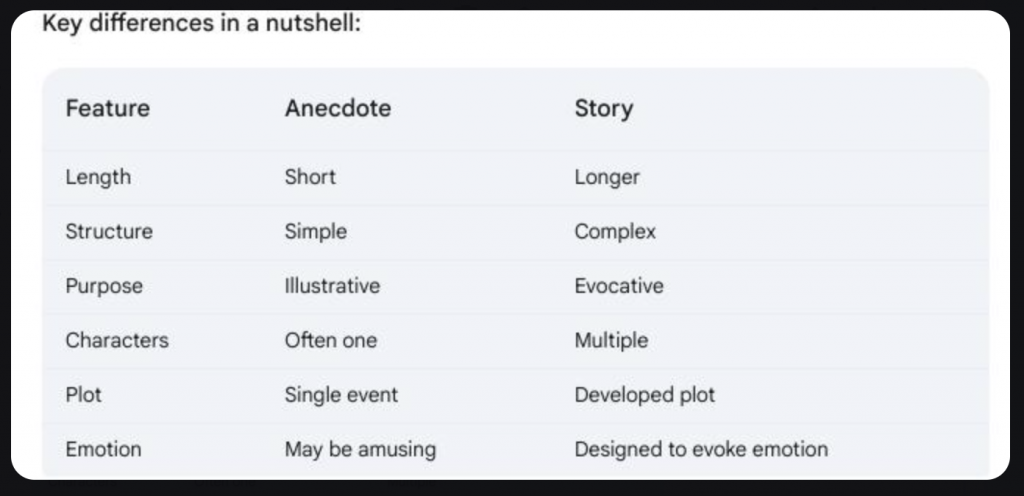
Storytelling
Storytelling is the art of conveying a narrative, idea, or message through a structured sequence of events, often with a beginning, middle, and end.
The terms “story” and “anecdote” are often used interchangeably, but they have distinct characteristics:
Anecdote:
- Short and simple: It’s a brief, often amusing or interesting account of a real incident or person.
- Focuses on a single event: It revolves around a specific point or incident.
- Informal: It’s usually told in a casual and conversational manner.
- Illustrative purpose: It’s often used to illustrate a point, make a joke, or add a personal touch to a conversation or presentation.
Story:
- More elaborate and structured: It has a clear beginning, middle, and end, with a plot that develops over time.
- Involves characters and conflict: It has characters who face challenges, overcome obstacles, and undergo some sort of transformation.
- Evokes emotions: It’s designed to engage the audience emotionally, making them feel invested in the outcome.
- Conveys a message or theme: It often has a deeper meaning or message that resonates with the audience.

Storytelling in Business
Storytelling in business is the practice of using narratives to communicate a brand’s message, values, products, or services in a way that resonates emotionally with an audience. It transforms data, facts, and business concepts into relatable and memorable stories that engage customers, employees, and stakeholders. Also see Using Storytelling in a Corporate Setting
Key Aspects of Storytelling in Business:
- Human Connection:
- Businesses use storytelling to build trust and emotional connections with their audience.
- Stories often highlight real-life experiences, customer success stories, or personal journeys of the founders.
- Purpose and Values:
- Stories communicate the mission, vision, and core values of the business, helping to differentiate it in the market.
- For example, a company might share how it supports sustainability through its practices.
- Problem-Solution Narrative:
- Many business stories revolve around identifying a problem (pain point) and showing how the product or service provides a solution.
- This approach emphasizes relevance and practical value.
- Customer-Centric Approach:
- Stories often feature customers as heroes, showcasing how the brand helped improve their lives or solve challenges.
- Authenticity:
- Authentic, transparent storytelling builds credibility. Audiences appreciate honest narratives that align with the brand’s actions.
- Emotional Impact:
- Emotional storytelling creates memorable experiences. Whether it’s humour, empathy, or inspiration, emotions drive audience engagement.
Storytelling in business isn’t about fictional tales but about using narrative elements to connect with your audience. Here’s an example:
Imagine a company launching a new productivity app.
Instead of a dry presentation with bullet points about features, they could use a story like this:
“Meet Sarah. She’s a project manager, juggling multiple deadlines and feeling overwhelmed. Emails pile up, meetings blur, and tasks slip through the cracks. She’s stressed and losing sleep. Then, she discovers [App Name]. With its intuitive interface and smart features, Sarah starts organizing her projects effortlessly. She gains clarity, meets deadlines, and even finds time for a yoga class. Now, Sarah is back in control, feeling calm and productive.”
Why this works:
- Relatability: Many people can relate to Sarah’s struggle. It creates an emotional connection.
- Problem/Solution: The story clearly presents a problem and how the app provides a solution.
- Humanizes the product: It’s not just about features but about how the app improves someone’s life.
- Memorable: Stories are stickier than facts and figures. People are more likely to remember Sarah’s journey.
Other examples of storytelling in business:
- About Us page: Instead of just listing achievements, tell the story of how the company was founded, its mission, and the people behind it.
- Customer testimonials: Use real customer stories to show how your product or service has helped them.
- Brand storytelling: Create a narrative around your brand that connects with your values and resonates with your target audience. (Think Dove’s “Real Beauty” campaign).
- Investor pitches: Use storytelling to make your business idea more compelling and memorable to potential investors.
By weaving narrative elements into their communication, businesses can make their messages more engaging, persuasive, and impactful and can turn ordinary interactions into meaningful experiences that inspire trust, loyalty, and action.
Storytelling Models:
There are various storytelling models, each suited to specific scenarios.
- 3-act structure
- Minto Pyramid Principle
- POET technique
- See it, Feel it, Believe it
- What? So what? Now what?
- In Medias Res
- The Hero’s Journey
- The 4 C’s
- Rags to Riches
Other good resources
https://www.yourthoughtpartner.com/blog/leadership-storytelling
https://pamdidner.com/blog/what-does-storytelling-mean-to-business/